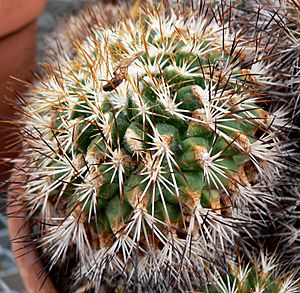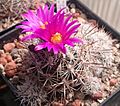Kadenicarpus horripilus facts for kids
Quick facts for kids Kadenicarpus horripilus |
|
|---|---|
 |
|
| Conservation status | |
| Scientific classification | |
| Synonyms | |
|
Kadenicarpus horripilus is a special kind of cactus plant. It belongs to the Cactaceae family, which is the family of all cacti. This plant is found only in one place: the state of Hidalgo in Mexico. It naturally grows in hot desert areas. Sadly, Kadenicarpus horripilus is an endangered species. This means there are not many of them left in the wild. Their biggest threat is habitat loss, which happens when their natural home is destroyed.
Contents
What it Looks Like
Kadenicarpus horripilus often grows in groups. It has olive-green bodies that are shaped like a ball or a stretched-out ball. These bodies can grow from 7 to 18 centimeters tall and 4 to 6.5 centimeters wide. The plant also has roots that look like fibers.
Spines and Thorns
This cactus has clear, cone-shaped bumps that are 5 to 7 millimeters high. It usually has one main spine that sticks out. This spine is straight and whitish, with a dark tip. It can be 12 to 18 millimeters long. Around the main spine, there are 12 to 14 other spines called radial spines. These are also straight, white with dark tips, and stick out. They are about 9 to 11 millimeters long.
Flowers and Fruits
The flowers of Kadenicarpus horripilus are a beautiful magenta color with a white center. They are about 2.2 to 3.1 centimeters long and 2.5 to 3.5 centimeters wide. After the flowers, the plant grows long, greenish-red fruits. When these fruits are ripe, they turn yellowish-brown. They are small, about 4 to 6 millimeters long and 3 to 5 millimeters wide.
Where it Lives
This cactus is endemic to the state of Hidalgo in Mexico. This means it is found naturally only in this specific area and nowhere else in the world. Its natural habitat is hot deserts, where it is very dry and warm.
Why it's Endangered
Kadenicarpus horripilus is listed as an endangered species. This is a serious problem because it means the plant is at a very high risk of disappearing forever. The main reason it is endangered is habitat loss. This happens when the places where the cactus naturally grows are destroyed or changed by human activities. For example, land might be cleared for farming, buildings, or roads. This takes away the cactus's home and makes it harder for it to survive and reproduce.
See also
 In Spanish: Turbinicarpus horripilus para niños
In Spanish: Turbinicarpus horripilus para niños




